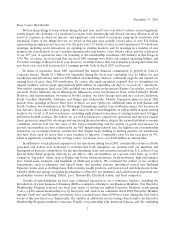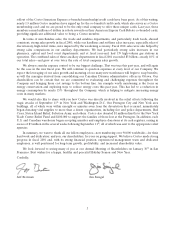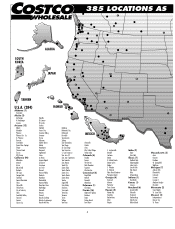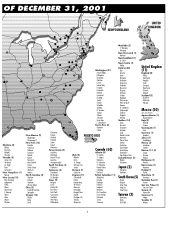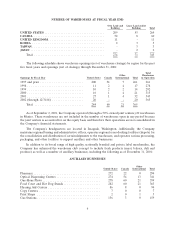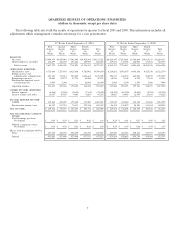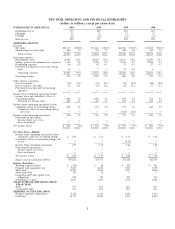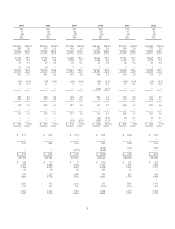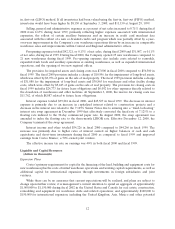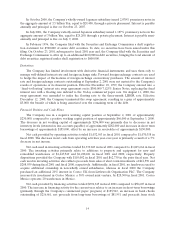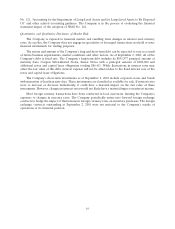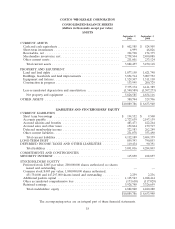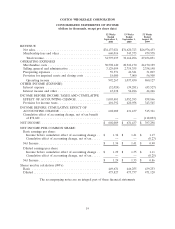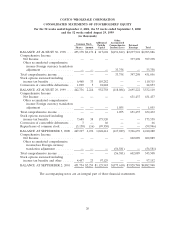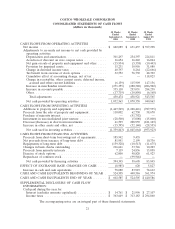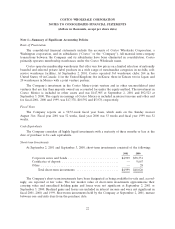Costco 2001 Annual Report Download - page 14
Download and view the complete annual report
Please find page 14 of the 2001 Costco annual report below. You can navigate through the pages in the report by either clicking on the pages listed below, or by using the keyword search tool below to find specific information within the annual report.in, first-out (LIFO) method. If all inventories had been valued using the first-in, first-out (FIFO) method,
inventories would have been higher by $8,150 at September 3, 2000, and $11,150 at August 29, 1999.
Selling, general and administrative expenses as a percent of net sales increased to 8.71% during fiscal
2000 from 8.67% during fiscal 1999, primarily reflecting higher expenses associated with international
expansion, the rollout of certain ancillary businesses and an increase in credit card merchant fees
associated with the rollout of a new co-branded credit card program which was partially offset by a year-
over-year improvement in the Company’s core warehouse operations driven by an increase in comparable
warehouse sales and improvements within Central and Regional administrative offices.
Preopening expenses totaled $42,321, or 0.13% of net sales, during fiscal 2000 and $31,007, or 0.11%
of net sales, during fiscal 1999. During fiscal 2000, the Company opened 25 new warehouses compared to
21 new warehouses during fiscal 1999. Pre-opening expenses also include costs related to remodels,
expanded fresh foods and ancillary operations at existing warehouses, as well as expanded international
operations, and the opening of two new regional offices.
The provision for impaired assets and closing costs was $7,000 in fiscal 2000 compared to $56,500 in
fiscal 1999. The fiscal 2000 provision includes a charge of $10,956 for the impairment of long-lived assets,
which was offset by $3,956 of gains on the sale of real property. The fiscal 1999 provision includes a charge
of $31,080 for the impairment of long-lived assets and $30,865 for warehouse and other facility closing
costs, which were offset by $5,445 of gains on the sale of real property. The provision for closing costs in
fiscal 1999 includes $24,773 for future lease obligations and $6,092 for other expenses directly related to
the closedown of warehouses and other facilities. At September 3, 2000, the reserve for closing costs was
$11,762, of which $8,887 related to future lease obligations.
Interest expense totaled $39,281 in fiscal 2000, and $45,527 in fiscal 1999. The decrease in interest
expense is primarily due to an increase in capitalized interest related to construction projects and a
decrease in the interest rate related to the 7.125% Senior Notes due to entering into a ‘‘fixed-to-floating’’
interest rate swap agreement in December 1999 that effectively converted the fixed rate of 7.125% to a
floating rate indexed to the 30-day commercial paper rate. In August 2000, the swap agreement was
amended to index the floating rate to the three-month LIBOR rate. Effective December 12, 2000, the
Company terminated the swap agreement.
Interest income and other totaled $54,226 in fiscal 2000 compared to $44,266 in fiscal 1999. The
increase was primarily due to higher rates of interest earned on higher balances of cash and cash
equivalents and short-term investments during fiscal 2000 as compared to fiscal 1999 and improved
earnings from Costco Mexico; a 50%-owned joint venture.
The effective income tax rate on earnings was 40% in both fiscal 2000 and fiscal 1999.
Liquidity and Capital Resources
(dollars in thousands)
Expansion Plans
Costco’s primary requirement for capital is the financing of the land, building and equipment costs for
new warehouses plus the costs of initial warehouse operations and working capital requirements, as well as
additional capital for international expansion through investments in foreign subsidiaries and joint
ventures.
While there can be no assurance that current expectations will be realized, and plans are subject to
change upon further review, it is management’s current intention to spend an aggregate of approximately
$1,000,000 to $1,150,000 during fiscal 2002 in the United States and Canada for real estate, construction,
remodeling and equipment for warehouse clubs and related operations; and approximately $100,000 to
$150,000 for international expansion, including the United Kingdom, Asia, Mexico and other potential
12


